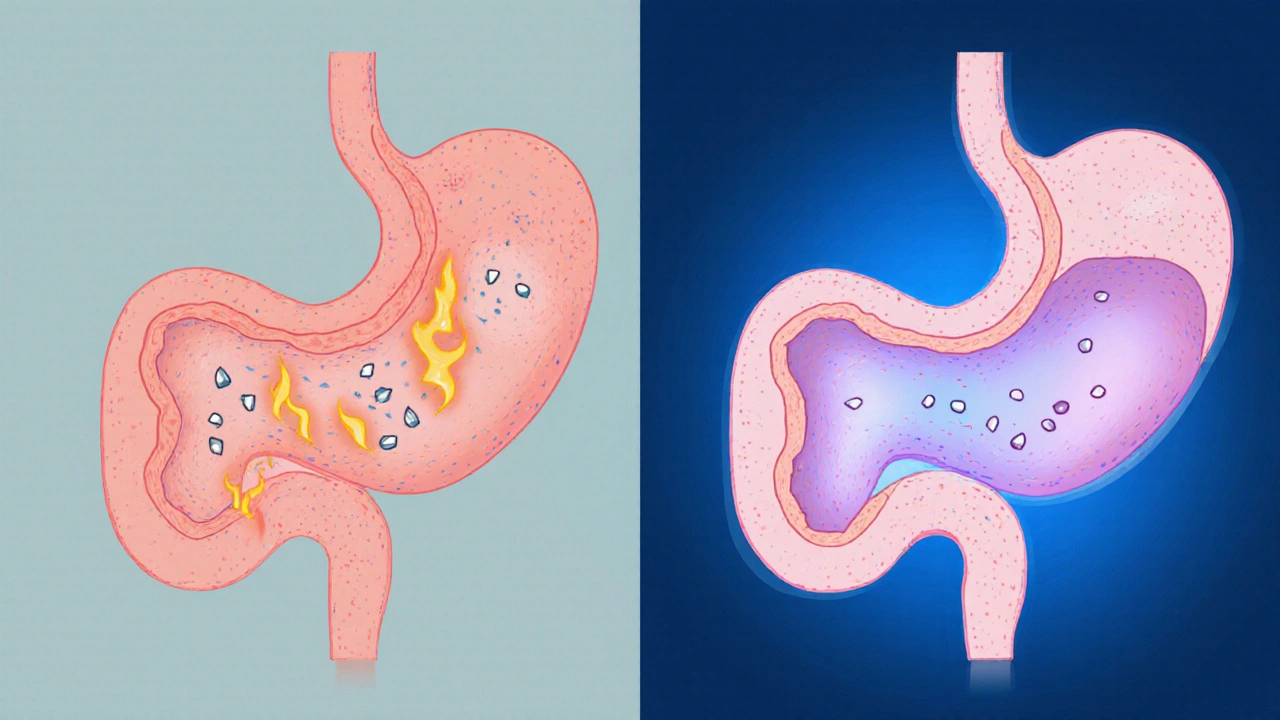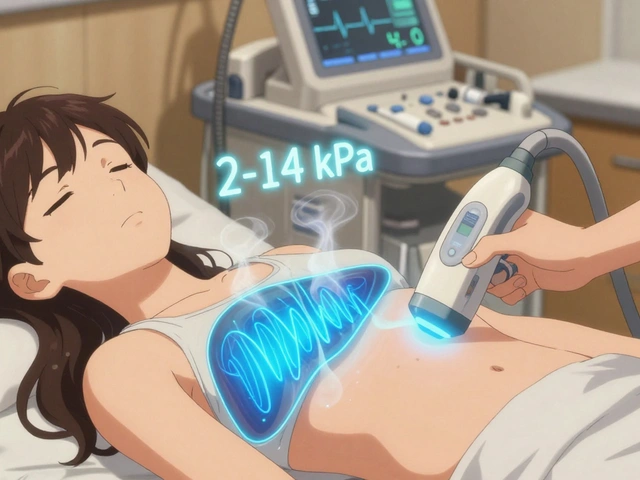Iron Supplement Comparison Tool
Recommended Supplement:
Key Details:
Why This Choice:
Comparison Table
| Form | Elemental Iron % | Daily Dose (mg) | Absorption | GI Side-effects | Cost (£/month) |
|---|---|---|---|---|---|
| Ferrous sulfate | 20% | 100-200 | High | Moderate-high | £3-£5 |
| Ferrous gluconate | 12% | 100-200 | Moderate | Low | £5-£7 |
| Ferrous fumarate | 33% | 100-200 | High | Moderate | £4-£6 |
| Carbonyl iron | 20% | 100-200 | Moderate | Very low | £6-£9 |
| Iron polysaccharide | 20% | 60-120 | Very high | Very low | £8-£12 |
| Iron bisglycinate | 20% | 30-60 | Very high | Very low | £10-£15 |
When you need a boost of iron, the shelves are crowded with names like Ferrous sulfate is a widely used iron salt that delivers a high dose of elemental iron per tablet. But is it the right choice for you? This guide compares ferrous sulfate with the most common alternatives, breaks down how they differ in absorption, side‑effects, cost, and helps you pick the supplement that matches your health goals.
Quick Take
- Ferrous sulfate offers the highest elemental iron (around 20% by weight) but can cause stomach upset.
- Ferrous gluconate is gentler on the gut, supplies less iron per pill, and is good for chronic users.
- Ferrous fumarate sits between the two in potency and tolerability.
- Carbonyl iron provides pure elemental iron with minimal gastrointestinal irritation.
- Iron polysaccharide and iron bisglycinate are newer, highly absorbable forms suitable for sensitive stomachs.
What Is Ferrous Sulfate?
Ferrous sulfate is a salt of iron (Fe²⁺) and sulfuric acid. In supplement form it usually appears as ferrous sulfate heptahydrate, delivering about 20mg of elemental iron per 325mg tablet. It’s inexpensive, widely available, and has a long track record for treating iron‑deficiency anemia.
Because the iron is in a simple ionic form, the body can absorb it quickly-provided the stomach is acidic enough. The downside is that the same chemical reactivity can irritate the lining of the stomach and cause constipation, nausea, or dark stools.
Common Alternatives to Ferrous Sulfate
Below are the five most popular iron salts you’ll see on pharmacy shelves.
- Ferrous gluconate: Iron bound to gluconic acid; milder on the stomach, about 12% elemental iron.
- Ferrous fumarate: Iron bound to fumaric acid; 33% elemental iron, decent absorption, moderate side‑effects.
- Carbonyl iron: Microparticulate elemental iron; virtually no gastrointestinal irritation, about 20% elemental iron.
- Iron polysaccharide (e.g., ferric maltol): Iron complexed with a carbohydrate matrix; high bioavailability and low discomfort.
- Iron bisglycinate: Iron chelated with two glycine molecules; excellent absorption and minimal side‑effects.
Each form changes how much iron you actually get per pill and how your gut reacts.

How the Supplements Differ
| Form | Elemental Iron % | Typical Daily Dose (mg elemental) | Absorption (relative) | GI Side‑effects | Cost (UK £ per month) |
|---|---|---|---|---|---|
| Ferrous sulfate | 20% | 100-200mg | High | Moderate‑to‑high | £3-£5 |
| Ferrous gluconate | 12% | 100-200mg | Moderate | Low | £5-£7 |
| Ferrous fumarate | 33% | 100-200mg | High | Moderate | £4-£6 |
| Carbonyl iron | 20% | 100-200mg | Moderate | Very low | £6-£9 |
| Iron polysaccharide | 20% | 60-120mg | Very high | Very low | £8-£12 |
| Iron bisglycinate | 20% | 30-60mg | Very high | Very low | £10-£15 |
The numbers above are averages from UK NHS formularies, product labels, and clinical studies published up to 2024.
Choosing the Right Iron Supplement
Think of the decision as matching three pieces: how much iron you need, how your stomach reacts, and your budget.
- Severity of deficiency. If blood tests show severe anemia (hemoglobin<10g/dL) you may need the highest elemental iron-ferrous sulfate or ferrous fumarate.
- Tolerance. If you experience nausea, constipation, or black stools with ferrous sulfate, switch to a gentler form like carbonyl iron or iron bisglycinate.
- Frequency of dosing. Some forms (polysaccharide, bisglycinate) are effective at lower doses taken once daily, which can simplify routines.
- Cost considerations. Generic ferrous sulfate remains the cheapest option, but the price gap has narrowed as newer formulations become more common in UK pharmacies.
Here’s a quick rule‑of‑thumb:
- First‑line, short‑term therapy for most adults: Ferrous sulfate (unless you’ve already had GI trouble).
- Long‑term maintenance or sensitive stomachs: Carbonyl iron or Iron bisglycinate.
- Budget‑tight patients who can tolerate mild side‑effects: Ferrous gluconate or Ferrous fumarate.
Practical Tips for Maximizing Iron Absorption
- Take your supplement on an empty stomach with a full glass of water, unless it upsets you.
- VitaminC boosts absorption-drink orange juice or chew a vitaminC tablet 30minutes before or after the iron dose.
- Avoid calcium‑rich foods, tea, coffee, or antacids within two hours of taking iron, as they hinder uptake.
- Check your lab results after 4-6weeks; adjust dose based on hemoglobin and ferritin trends.
- If you’re pregnant, consult your GP-iron needs rise to about 30mg elemental iron daily.
Mini‑FAQ
Can I switch from ferrous sulfate to another iron supplement without a doctor’s note?
Most healthy adults can change over‑the‑counter iron types on their own, but if you’ve been diagnosed with anemia, it’s wise to let your GP know. They can retest your blood levels after a few weeks to make sure the new form is working.
Why do iron pills turn my stool black?
Unabsorbed iron reacts with digestive enzymes and bacteria, forming ferric sulfide-a black compound. It’s harmless, but if you notice blood‑red stool, contact a doctor.
Is iron polysaccharide better than ferrous sulfate for vegetarians?
Yes, because it’s highly absorbable and doesn’t rely on meat‑derived heme iron. Vegetarians often benefit from the gentler gut profile of polysaccharide or bisglycinate forms.
How long should I stay on an iron supplement?
Typically 3-6months after blood levels normalize, then shift to a maintenance dose (often half the therapeutic dose) to keep ferritin stable.
Do iron supplements interact with other medications?
Yes. Antibiotics like tetracycline and fluoroquinolones, thyroid meds, and bisphosphonates can bind iron and reduce absorption. Space them at least two hours apart.

Bottom Line
If you need a fast, cost‑effective way to replenish iron stores and can handle a bit of stomach upset, ferrous sulfate remains the go‑to choice. For chronic users, sensitive intestines, or when you’re looking for the highest absorption per milligram, explore carbonyl iron, iron polysaccharide, or iron bisglycinate. Always pair the supplement with vitaminC, monitor your labs, and talk to a healthcare professional if you’re unsure which form fits your lifestyle.





15 Comments
Sharon Lax
October 1, 2025While the article offers a decent overview, it fails to acknowledge the pharmacokinetic nuances that differentiate ferrous sulfate from chelated complexes. The discussion could benefit from integrating bioavailability coefficients and the impact of gastric pH on iron oxidation states.
paulette pyla
October 5, 2025Oh great, another ‘ultimate guide’ that pretends iron supplements are all the same. If you think a £3 tablet beats a sophisticated bisglycinate because it’s cheaper, you’re clearly living under a rock.
Benjamin Cook
October 8, 2025Hey folks!!! If you’re feeling drained, grab a dose of iron and power up!!! Just remember to take it with vitamin C for better absorption!! Oops I meant ‘take it with orange juice’ lol!!
karthik rao
October 11, 2025While enthusiasm is commendable, the statement lacks precision. The term “power up” is colloquial and does not convey the requisite biochemical mechanisms. Moreover, ingesting iron without considering heme versus non‑heme pathways can lead to suboptimal outcomes. 🧐
Breanne McNitt
October 14, 2025I totally agree with the point about vitamin C-pairing it with iron really does the trick. Also, if anyone’s on a tighter budget, the ferrous sulfate option is solid as long as you can tolerate the occasional tummy upset.
Ashika Amirta varsha Balasubramanian
October 16, 2025Balancing cost and comfort is indeed a philosophical exercise: we weigh the material value against the intangible quality of well‑being. For those with sensitive stomachs, investing a bit more in bisglycinate feels like honoring one’s own body as a temple.
Jacqueline von Zwehl
October 18, 2025Just a quick note: the table mixes “elemental iron %” with “daily dose (mg)”. It would be clearer to present both in absolute elemental iron amounts for better comparison.
Christopher Ellis
October 20, 2025Clarity is key. When you express data consistently, readers can evaluate efficacy without extra mental gymnastics.
kathy v
October 22, 2025Let me unpack this at length because the stakes of iron supplementation are far greater than most realize. Iron is not merely a mineral you pop to ward off fatigue; it is integral to mitochondrial respiration, DNA synthesis, and immune function, each of which underpins daily vitality. When iron deficiency persists, the body reallocates limited iron stores, prioritizing erythropoiesis over neurocognitive processes, which explains why many patients experience “brain fog” beyond simple anemia. Consequently, the choice of supplement should be guided by more than just elemental percentage. A high‑absorption chelate like bisglycinate may deliver double the usable iron compared to ferrous sulfate, but its higher cost can be justified if gastrointestinal tolerance is a concern. Conversely, carbonyl iron, while cheaper than bisglycinate, offers a delayed release that may suit individuals with moderate deficiency and a relatively robust gut lining. It is also worth noting that the form of iron influences oxidative stress; free iron can catalyze the Fenton reaction, producing harmful radicals, which is why formulations that tightly bind iron reduce systemic oxidative damage. Moreover, the timing of ingestion matters: taking iron on an empty stomach maximizes absorption, yet for those with acid reflux, a light snack can mitigate irritation without drastically compromising uptake. Vitamin C, as many have highlighted, acts as a potent enhancer by reducing Fe³⁺ to Fe²⁺, thereby facilitating transporter affinity, so pairing any iron supplement with a citrus source is advisable. In assessing cost, one must consider the hidden expenses of side‑effects-gastrointestinal discomfort can lead to missed doses, nullifying any financial savings from cheaper formulas. Lastly, patient education is paramount; many assume dark stools are a sign of toxicity, when in fact they indicate normal iron excretion. Proper counseling can improve adherence and overall therapeutic success. In sum, while ferrous sulfate remains the workhorse for many, the decision matrix should encompass absorption efficiency, side‑effect profile, cost, and individual physiological factors.
Jorge Hernandez
October 24, 2025✅ Spot on! I always add a splash of orange juice with my iron-no more upset stomach 😊.
Raina Purnama
October 26, 2025Your thorough explanation helps a lot, especially the part about oxidative stress. It’s good to remember that cheaper isn’t always better if it leads to missed doses.
Rebecca Bissett
October 27, 2025Wow!! This is incredibly helpful!! I feel so much more confident about choosing the right supplement!! Thank you!!
Michael Dion
October 29, 2025Iron supplements are overpriced.
Trina Smith
October 30, 2025🧘♀️ Money talks, but health whispers. Finding balance is the key.
josh Furley
November 1, 2025Bottom line: match the iron type to your gut, budget, and lifestyle-no one‑size‑fits‑all.